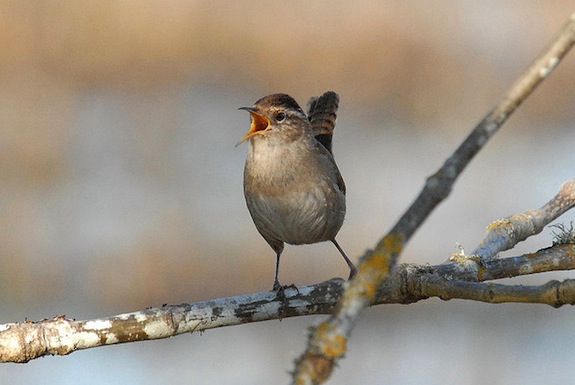The Irish Used to Celebrate the Day After Christmas by Killing Wrens
If you’ve ever wanted to celebrate the day after christmas by hunting down a small bird and tying it to the top of a pole, move to Ireland

Image: Dan Dzurisin
In Ireland, the day after Christmas means hunting down a small bird and tying it to the top of a pole. That’s how the Irish celebrate St. Stephens Day, or Wren Day. Irish Festivals explains:
Celtic myth had it that the robin that was suppose to represent the New Year killed the wren which represented the Old Year during this time.
You’ve probably heard a wren’s song before, but it sounds something like this:
That is, before it’s caught and killed, which on Wren Day is done by young boys also called Wrenboys or Mummers:
Originally, groups of small boys would hunt for a wren, and then chase the bird until they either have caught it or it has died from exhaustion. The dead bird was tied to the top of a pole or holly bush, which was decorated with ribbons or colored paper.
Early in the morning of St. Stephen’s Day, the wren was carried from house to house by the boys, who wore straw masks or blackened their faces with burnt cork, and dressed in old clothes. At each house, the boys sing the Wren Boys’ song.
That song sounds like this:
Or, in Irish, like this:
The lyrics are:
The wren, the wren, the king of all birds,
St. Stephen’s Day was caught in the furze,
Although he was little his honour was great,
Jump up me lads and give us a treat.
As I was going to Killenaule,
I met a wren upon the wall.
Up with me wattle and knocked him down,
And brought him in to Carrick Town.
Drooolin, Droolin, where’s your nest?
Tis in the bush that I love best
In the tree, the holly tree,
Where all the boys do follow me.
Up with the kettle and down with the pan,
And give us a penny to bury the wren.
I followed the wren three miles or more,
Three miles or more three miles or more.
I followed the wren three miles or more,
At six o’clock in the morning.
I have a little box under me arm,
Under me arm under me arm.
I have a little box under me arm,
A penny or tuppence would do it no harm.
Mrs. Clancy’s a very good woman,
a very good woman, a very good woman,
Mrs. Clancy’s a very good woman,
She give us a penny to bury the wren.
Where exactly this whole wren murdering business came from is somewhat unclear, but there are a few stories:
One is that St. Stephen, hiding from his enemies in a bush, was betrayed by a chattering wren. The wren, like St. Stephen, should be hunted down and stoned to death. Another legend holds that during the Viking raids of the 700′s, Irish soldiers were betrayed by a wren as they were sneaking up on a Viking camp in the dead of night. A wren began to eat breadcrumbs left on the head of a drum, and the rat-a-tat-tat of its beak woke the drummer, who sounded the alarm and woke the camp, leading to the defeat of the Irish soldiers and the continuing persecution of the wren.
Today, no wrens are harmed in the name of Wren Day. In fact, the holiday is barely celebrated in a lot of places in Ireland. The town of Dingle has a whole parade though:
Come Wren’s Day, thousands of spectators line the streets of Dingle to watch this spectacle of men, dressed in rigs and brightly colored costumes, take over the town.
Starting at noon and going on until the early hours of the following day, The Wran is a blaze of color and a lot of noise, thanks not only to the accompanying musicians’ fife and drums, but to the collection boxes the wran boys shake. Rather than paying for a dance for the whole town, today’s funds go to local charities.
Be warned. Innocent by-standers will often get swept into the parade or chased down side-streets.
No longer to wrens have to fear Wren Day, but it seems like if you’re in Dingle, you might.
More from Smithsonian.com:
Mother Birds Teach Their Eggs a Secret ‘Feed Me!’ Password
What Do You Call a Flock of Birds?
/https://tf-cmsv2-smithsonianmag-media.s3.amazonaws.com/accounts/headshot/Rose-Eveleth-240.jpg)
/https://tf-cmsv2-smithsonianmag-media.s3.amazonaws.com/accounts/headshot/Rose-Eveleth-240.jpg)